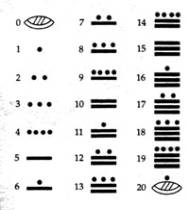The life of the Maya revolved around the concept of time. Priests were consulted on civil, agricultural and religious matters, and their advice would be derived from readings of the sacred calendars. Time was of such importance that children were even named after the date on which they were born.
Maya math uses only three symbols - a shell-shaped glyph for zero, a dot for one and a bar for five to represent units from zero to 19. For instance, the number 13 was represented as three dots and two bars.
|
|
Zero was an advanced concept in those days, something that the Romans were not aware of. Yet the Maya were comfortable enough with it to use a shell as its symbol, a tangible object representing an abstract concept. The Maya also used metrical calculation and place numeration, which were very clever for a culture that didn't use the wheel!
Although they had many calendars, they marked the passage of time with three cycles that ran in parallel.
The first is the scared calendar known as the Tzolkin. It combines the numbers from 1 through 13 with a sequence of 20 day-names. It works in a similar manner to our named days of the week, and their date within each month. So you might have 5-Chikchan (like our Sunday the 5th) followed by 6-Kimi (as we would have Monday the 6th). After 260 days the same number/name combination will re-occur, and the calendar starts anew. Their use of the vigesimal (base 20) numbering system probably relates to fingers and toes, whereas the 13 nicely fits the growth phase of the moon which isn't visible when new and appears full for two days on end, thus appearing to have a 13 day growth cycle. Alternatively, the length of the Tzolkin may be related to the human gestation period of nine months (273 days). It has been suggested that 260 days is the time between a woman suspecting her pregnancy (she doesn't menstruate) and when she gives birth.
The second is the agricultural calendar known as the Haab, or vague year. It consists of 18 months, each of 20 days. An addition of a five-day month (a period of apprehension and bad luck named Uayeb) gives us 365 days, an approximation of a year. This calendar's primary purpose was to keep track of the seasons, for seasonal and solar events would occur on roughly the same day of each year. The Maya were aware of the annual quarter day discrepancy, but it is not known if they ever did anything about it.
These two independently running calendars each begin again every 260 and 360+5 days. However, every 52 years they coincide:
"The Tzolkin and the Haab ran concurrently, like intermeshed cog-wheels, and to return to any given date, 52 years, or 18,980 days, would have to elapse (because both 365 x 52 and 260 x 73 = 18,980). In other words, the Tzolkin would make 73 revolutions and the Haab 52, so that every 52 calendar years of 365 days one would return to the same date. A complete date in this 52-year cycle might be, for example, 2 1k 0 Pop (2 1k being the position of the day in the Tzolkin, 0 Pop the position in the Haab). Fifty-two years would pass before another 2 1k 0 Pop date returned.
It was expected that the world would end at the completion of a 52-year cycle. At this time, among the Mexica in the Valley of Mexico, all fires were extinguished, pregnant women were locked up lest they be turned into wild animals, children were pinched to keep them awake so that they would not turn into mice, and all pottery was broken in preparation for the end of the world. In the event the gods decided to grant man another 52 years of life on earth, however, a night time ceremony was held in which the populace followed the priests through the darkness over a causeway to the top of an old extinct volcano that rises abruptly from the floor of the basin of Mexico, known today as the Hill of the Star, the hill above Ixtapalapa. There, with all eyes on the stars, they awaited the passage of the Pleiades across the center of the heavens, which would announce the continuation of the world for another 52 years. When the precise moment came, a victim was quickly sacrificed by making a single gash in his chest and extracting the still palpitating heart. In the gory cavity the priests, with a fire drill, kindled a new flame that was quickly carried by torches across the lake to the temple in Tenochititlan, and from there to all temples and villages around the lake. This was known as the New Fire Ceremony among the Mexica, and in some way this same completion and renewal of each 52-year cycle was recognized by all Mesoamericans."[i]
This is not unlike how the end of the last millennium may have felt for many Christians or doomsday cult followers.
Our modern Western calendar was first introduced in Europe in 1582. It was based upon the Gregorian calendar, which calculated the Earth's orbit to take 365.25 days. This was 0.0003 of a day per year too much, but still exceptionally accurate for scientists living over 400 years ago.
The Mayan calendars were derived from those of their predecessors, the Olmec, whose culture dates back at least 3,000 years. Without the instruments of 16th century Europe, these Central American locals managed to calculate a solar year of 365.2420 days, just 0.0002 of a day short. More accurate than the Europeans, and much earlier. It is not known if the Olmecs created the Long Count calendar, or if they received it from an even earlier civilisation...

0 comments:
Post a Comment